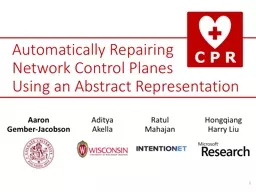

Network Control Planes Using an Abstract Representation Ratul Mahajan Aaron Gember Jacobson Aditya Akella Hongqiang Harry Liu 1 Control plane heart of the network 2 Control plane ID: 649601
Download Presentation The PPT/PDF document "Automatically Repairing" is the property of its rightful owner. Permission is granted to download and print the materials on this web site for personal, non-commercial use only, and to display it on your personal computer provided you do not modify the materials and that you retain all copyright notices contained in the materials. By downloading content from our website, you accept the terms of this agreement.
Slide1
Automatically Repairing Network Control Planes Using an Abstract Representation
RatulMahajan
Aaron
Gember
-Jacobson
Aditya
Akella
Hongqiang
Harry Liu
1Slide2
Control plane == heart of the network
2
Control
planeSlide3
Configuring the control plane
3
Protocol instances
Link/path weights
Traffic filters
…
Allow Alice & Bob’s computers to communicate
Bob
Alice
Complex!Slide4
Configuration errors are common
4
Took hours
to
repair the networkSlide5
Existing toolsSynthesis (e.g., SyNET, Propane)
Verification (e.g., ARC, Minesweeper)
5
Verifier
Configurations
Policies
Violations
Synthesizer
Correct
configurations
PoliciesRepeat when policies change
Entirely new
configurations
☹️
Operator
Repaired
configurations
Manual intervention
☹️Slide6
Our contribution: CPR6
Broken
configurations
Repaired
configurations
PoliciesSlide7
Challenges7
Broken
configurations
Repaired
configurations
Compute repairs that
…
1) Satisfy
all
policies2) Are feasible to implement3) Require minimal changesPolicies
Inspiration:network verification & program repairSlide8
Our approach8
Policies
Broken
configurations
Repaired
configurations
Repaired model
Graph-based model
Constraint problem
A
B
A =?, B = ?Slide9
Example networkPoliciesR ⇨ T prefers A→ B → C
S ⇨ T traverses firewallS ⇨ T reachable under single link failure
9
B
C
A
OSPF
OSPF
OSPF
R
S
T
FWSlide10
∞
∞
∞
∞
∞
0
0
0
00
PoliciesR ⇨ T prefers A→ B → CS ⇨ T traverses firewallS ⇨ T reachable under single link failure
AOBO
C
O
A
I
B
I
C
I
1
1
0
0
0
0
0
1
1
R
T
Background: ARC [
SIGCOMM’16
]
10
Max-flow = 1
B
C
A
OSPF
OSPF
OSPF
R
S
T
FW
S
T
FW
FW
1 edge-disjoint path
Shortest path
1
1
A
O
B
O
C
O
A
I
B
I
C
I
FW
FW
1
1Slide11
∞
∞
∞
∞
∞
Policies
R ⇨ T prefers A→ B → C
S ⇨ T traverses firewall
S ⇨ T reachable under single link failure
AO
BOCOAI
B
I
C
I
R
T
1
1
0
0
0
0
0
1
1
Repairing ARC
11
FW
FW
1
1
Max-flow = 1
A
O
B
O
C
O
A
I
B
I
C
I
S
T
1
1
FW
FW
Add and remove
edges in the ARC
2
1
Challenge:
satisfying multiple policies
NP-hard
☹️Slide12
Repair as constraint solvingBoolean variables: for each possible edge in each graph
Constraints: on pathse.g., S ⇨ T traverses firewall∄ Path
without a FW from S to T
Base case: edge
—
without a FW
path
without a FW
Inductive case: path without a FW & edge — without a FW path
without a FW 12
S
TSlide13
Policies
R ⇨ T prefers A→ B → C
S ⇨ T traverses firewall
S ⇨ T reachable under single link failure
A
O
B
O
C
OAI
BICI
R
T
1
1
0
0
0
0
0
1
1
Satisfying solution
13
FW
FW
1
1
Max-flow = 1
B
O
C
O
A
I
B
I
S
T
1
1
FW
FW
2
Is it a
feasible
solution?
0
0
0
0
0
A
O
C
I
1
FWSlide14
A
I
B
R
S
T
FW
B
O
C
OBI
R
T
1
1
0
0
0
0
0
1
1
Translating repairs
14
FW
FW
1
1
B
O
C
O
A
I
B
I
S
T
1
1
FW
FW
Challenge: conflicts between traffic classes
0
0
0
0
0
OSPF
C
A
OSPF
OSPF
A
O
C
I
1
A
O
C
I
Cannot enable routing
for a single
Src-Dst
pair
FW
FWSlide15
R
0
Hierarchical ARC
15
S
1
1
T
A
O
B
O
C
O
A
I
B
I
C
I
1
0
0
0
0
1
FW
FW
1
FW
1
FW
1
FW
Is it
a
minimal
solution
?
0
FW
FW
1
1
B
O
C
O
A
I
B
I
T
1
1
A
O
C
I
0
0
0
0
1
1
T
A
O
B
O
C
O
A
I
B
I
C
I
1
0
0
0
0
1
FW
FW
1
1
T
A
O
B
O
C
O
A
I
B
I
C
I
1
0
0
0
0
1
FW
FW
Disallow conflicts in model
Add constraints to enforce hierarchy
3
3
3Slide16
Each edge addition/removal requires a configuration change
Maximum satisfiability problemHard constraints: discussed earlierSoft constraints:
edge in original HARC
edge in repaired HARC (and vice versa)Objective: satisfy as many soft constraints as possible
Repair
minimality
16
Slide17
Evaluation: dataset96 real data center networks
Synthetic fat tree
configurations
17Median =
8Max = 24
Median
=
1K
Max = 82KPoliciesRouters
Repair older configurations
to satisfy newer policiesTwosnapshotsSlide18
Evaluation: performance
18
86% repaired in < 1 minute
99% repaired in < 1 hour
8 hours
72% repaired in < 8 hours
2 orders of magnitude reduction
1 hour1 minute Slide19
Evaluation: CPR vs hand-written repairs19
CPR changes
same or fewer
lines in 79%
of networks
Overlapping
filtering rules
are condensed
in hand-writtenrepairsSlide20
SummaryAutomatically repair configurations for distributed control planesFormulate a
maximum satisfiability problem based on hierarchical ARCCompute repairs for small data centers in < 1
hour20
Try It
! http://aaron.gember-jacobson.com/go/
cpr Slide21
Dataset: real data center policies
21
S ⇨ T blocked
S
⇨ T reachable under single link failureSlide22
Evaluation: scalability (fat trees)
22